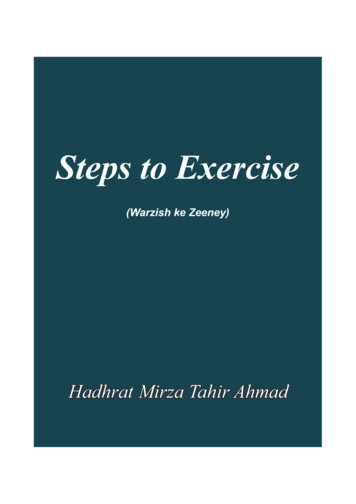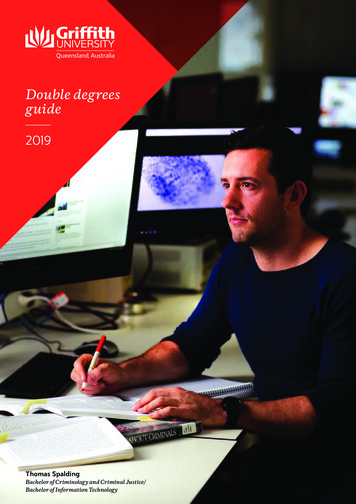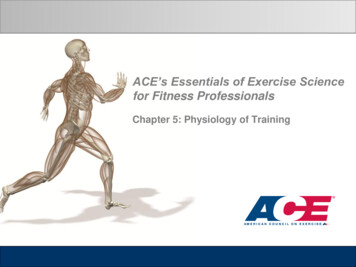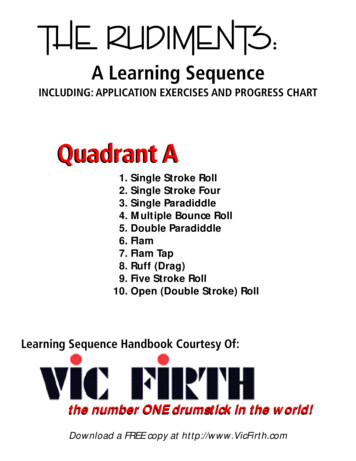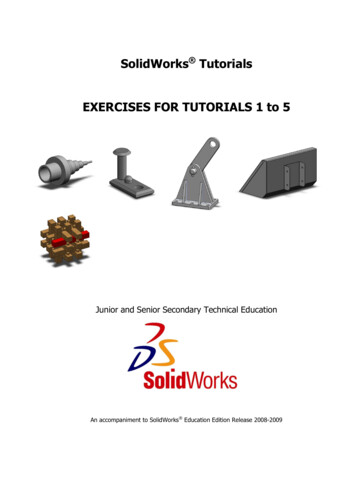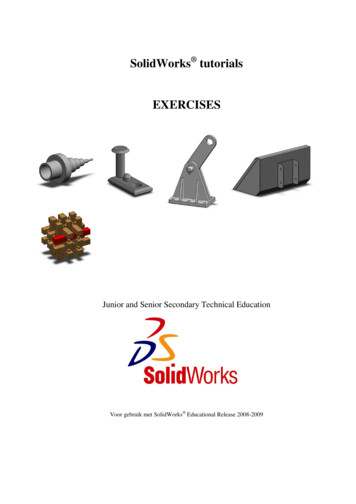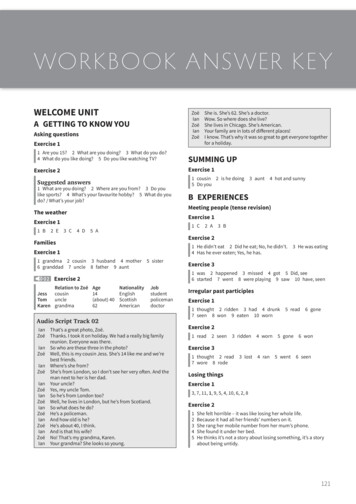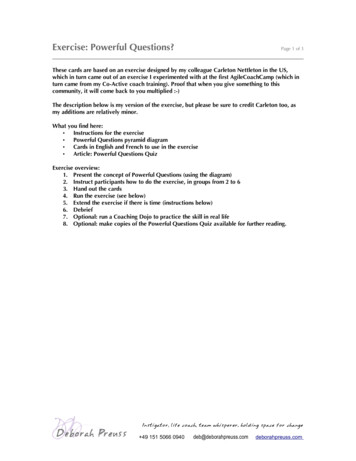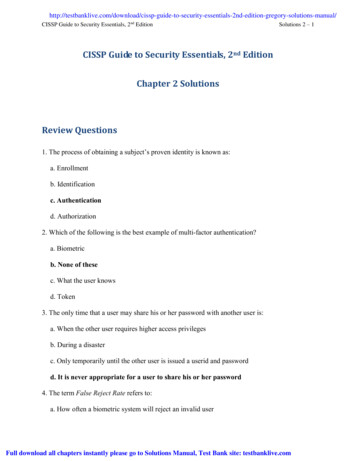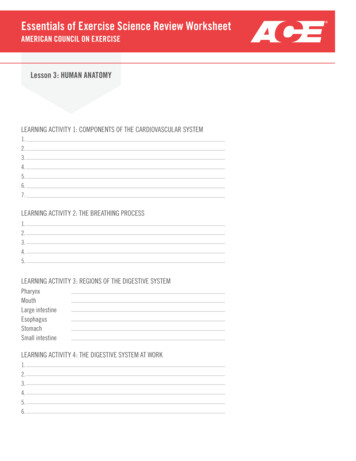
Transcription
Essentials of Exercise Science Review WorksheetAMERICAN COUNCIL ON EXERCISELesson 3: Human AnatomyLearning Activity 1: Components of the Cardiovascular System1.2.3.4.5.6.7.Learning Activity 2: THE BREATHING PROCESS1.2.3.4.5.Learning Activity 3: REGIONS OF THE DIGESTIVE SYSTEMPharynxMouthLarge intestineEsophagusStomachSmall intestineLearning Activity 4: THE DIGESTIVE SYSTEM AT WORK1.2.3.4.5.6.
Learning Activity 5: JOINTS AND THEIR CORRESPONDING rning Activity 6: MOVEMENT TERMINOLOGY1.2.3.4.5.6.7.8.9.Learning Activity 7: COMPONENTS AND FUNCTIONS OF THE NERVOUS SYSTEM1.2.3.4.5.6.Learning Activity 8: ANATOMICAL STRUCTURE OF NEURONS1.2.3.4.5.Learning Activity 9: RECEPTORS OF THE NERVOUS SYSTEMGogli Tendon Organs1.2.3.4.Muscle Spindles1.2.3.4.
Learning Activity 10: muscle-fiber types1. Type I: Slow-twitch; small amount of mitochondria; fatigue-resistant; used during anaerobic metabolism; usedduring sports such as cross-country running2.2. Type IIx: Fast-twitch; also known as fast-glycolytic; small amount of mitochondria; less resistant to fatigue3.than type I fibers; largest and fastest fibers; limited capacity for aerobic metabolism4.3. Type IIa: Fast-twitch; can be trained to be more oxidative or glycolytic; can only sustain activity for less than5.30 secondsLearning Activity 11: the role of connective tissue1.2.3.4.5.6.Learning Activity 12: the shoulder girdle in action1.2.3.4.5.6.Learning Activity 13: the shoulder complex1.2.3.4.Learning Activity 14: forearm and elbow muscles1.2.3.4.Learning Activity 15: trunk muscles at work1.2.3.4.
Learning Activity 16: hip muscles and their actions1. Gluteus maximus: Extension, external rotation, adduction2. Gracilis: External rotation, adduction, flexion3. Rectus femoris: Abduction, flexion, internal rotation4. Tensor fasciae latae: Flexion, abduction, internal rotation5. Pectineus: Flexion, adduction, external rotation6. Biceps femoris: Extension, abduction, adduction, external rotation7.Semitendinosus: Extension, adduction, slight internal rotation8. Piriformis: Adduction, flexion, external rotationLearning Activity 17: the knee joint1.2.3.4.Learning Activity 18: the ankle and foot1.2.3.4.Learning Activity 19: hormones and thier functions1.2.3.4.5.6.
Essentials of Exercise Science Review WorksheetAMERICAN COUNCIL ON EXERCISELesson 4: exercise physiologyLearning Activity 1: concepts of physical fitness1.2.3.4.5.Learning Activity 2: PHYSIOLOGY OF THE CARDIORESPIRATROY SYSTEM1.2.3.4.Learning Activity 3: ENERGY SYSTEMS1.2.3.4.5.6.
Learning Activity 4: RESPIRATORY EXCHANGE RATIOLearning Activity 5: acute and chronic responses to aerobic exercise1.2.3.4.5.Learning Activity 6: hormonal responses to exercise1.2.3.4.Learning Activity 7: environmental considerations when exercising1.2.3.4.
Essentials of Exercise Science Review WorksheetAMERICAN COUNCIL ON EXERCISELesson 5: fundamentals ofapplied kinesiologyLearning Activity 1: physics and human movement1.2.3.4.Learning Activity 2: the balanced and moving body1.2.3.4.5.
Learning Activity 3: evaluating movements of the hip1.2.3.Learning Activity 4: evaluating movements of the knee1.2.Learning Activity 5: evaluating movements of the ankle1.2.Learning Activity 6: review of the lower extremity1.2.3.4.5.6.Learning Activity 7: restore the core1.2.3.4.5.Learning Activity 8: the shoulder complex in action1.2.3.4.5.6.
Learning Activity 9: special populations
Essentials of Exercise Science Review WorksheetAMERICAN COUNCIL ON EXERCISELesson 6:nutritionLearning Activity 1: nutrients1.2.3.4.5.6.7.Learning Activity 2: federal guidelines1.2.3.4.Learning Activity 3: food labels1.2.3.4.5.6.Learning Activity 4: determining rmrAnswer:
Learning Activity 5: weight-loss strategies1.2.3.4.5.Learning Activity 6: nutrients and exercise1.2.3.Learning Activity 7: nutrition and special populations1.2.3.4.Learning Activity 8: scope of practice1.2.3.4.
Essentials of Exercise Science Review WorksheetAMERICAN COUNCIL ON EXERCISELesson 7: physiologyof trainingLearning Activity 1: acute responses to exercise1.2.3.4.5.6.Learning Activity 2: fuel sources1.2.3.4.Learning Activity 3: thermoregulationLearning Activity 4: changes in the cardiorespiratory system1.2.3.4.5.
LEARNING ACTIVITY 5: TRAINING PRINCIPLES1.2.3.4.LEARNING ACTIVITY 6: MUSCULAR ADAPTATIONS1. Increase in the number of actin and myosin filaments2. Decrease in the levels of the sarcoplasm3. Increase in the amount of lactate that is produced4. Increase in the body’s ability to buffer lactic acid5. Increase in the levels of testosterone and growth hormone6. Decrease in the production of new muscle fibers7.Increase in the utilization of type I fibers8. Increase in neuromuscular adaptationsLEARNING ACTIVITY 7: STRETCHING TECHNIQUES1.2.3.4.5.
Learning activity 10: muscLe-fiBer types 1. type I: slow-twitch; small amount of mitochondria; fatigue-resistant; used during anaerobic metabolism; used during sports such as cross-country running 2. 3. type IIx: fast-twitch; also known as fast-glycolytic; small amount of mitochondria; less resistant to fatigue than type i fibers; largest and fastest fibers; limited capacity for aerobic File Size: 606KBPage Count: 13

